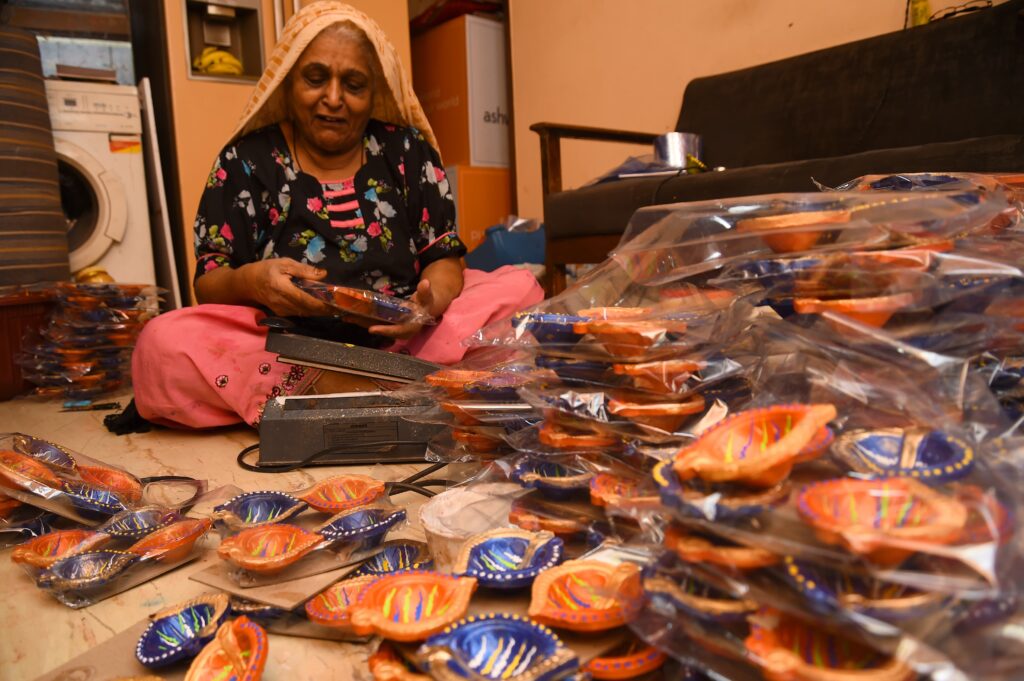
Meet Ibrahim Yusuf Bharwada. He is 79. A potter who has been giving shape to earthen lamps for the past 69 years. For nearly seven decades, Ibrahim’s hands have moulded clay into symbols of light and tradition, shaping diyas and pots in the heart of Kumbharwada, Dharavi, Mumbai. His hands are rough, but steady, carrying the weight of generations that have practiced this craft before him. In this small corner of Dharavi, Ibrahim stands as one of the many guardians of an ancient art, passed down through bloodlines and carried forward by the collective spirit of the community.
“I started when I was just 10,” Ibrahim recalls with a nostalgic smile. “Back then, it wasn’t just about making diyas. It was about survival, about continuing what my father and his father did. Today, it is more than that—it is about keeping a flame of art and identity alive.”

Ibrahim is just one of the many potters in Kumbharwada. The area is home to nearly 3,000 potter families, a mix of Gujarati, Kutchi and Muslim potters, all bound by their connection to the clay and fire.
What makes Kumbharwada unique is not just its mastery of clay—it is a shared legacy. For nearly a century, generations of potters, often from different religions and communities, have carried the ancient art of crafting clay into the modern age, keeping alive not just a trade but a tradition bound by family ties, culture, and community spirit. Their hands tell stories of resilience, crafting not just pots and diyas but vessels of cultural survival.

“The kiln doesn’t care about religion,” says Ibrahim. “It fires the pot the same way, no matter whose hands shape it. We share our work, and we share our lives. Once the clay is shaped, we all wait for the same fire to finish what we have started.” This metaphorical fire, both literal in the kilns and figurative in their collective spirit, has kept the potters united even as Dharavi transforms.
Mansukh Hukkabhai Chitroda, a 3rd generation potter from the community shared, “Our forefathers came here with nothing but their craft. Dharavi is more than home—it is where our hands, and the earth, come together. In Kumbharwada, we don’t see differences. We all come from the same earth, and we shape it into something beautiful, something that brings light.”
The Struggles Beyond the Wheel
While the potters of Kumbharwada have thrived by carrying their heritage forward, the path has not always been easy. Imported diyas and cheap plastic alternatives have flooded the market, threatening to extinguish their light. Still, the potters persist, as they have for decades, adapting to new market demands while fiercely protecting the authenticity of their craft.
“Cheap alternatives come and go, but the connection people feel to clay is timeless,” one potter said, reflecting on the impact of foreign imports. “We have seen hard times, but we are not afraid. We have survived before, and we will again,” says Hanif Galwani, a potter who owns a small-scale pottery business in Dharavi. “People may buy plastic diyas today, but they always come back to clay. There is a connection to the earth that no factory can replace,” he smiles.

Keeping the Tradition Alive Amid Modern Challenges
Despite challenges, the community of Kumbharwada is lighting up a brighter future. The order of about 10 lakh diyas from Kumbharwada by large corporations and initiatives like the Dharavi Social Mission has provided hope. These diyas are more than earthen lamps—they are symbols of survival, artistry, and the flame that refuses to die in the face of adversity.
“This is not just an order, it is a symbol,” said Husainbhai Vaghadia, President of the Kutchi Kumbhar Community. “When people light our diyas during Diwali, they are lighting the continuation of a tradition that has existed for generations. Dharavi is our anchor, but our clay carries the light to homes across the Mumbai city, and beyond.”

As Ibrahim Yusuf and other potters stand before their wheels, with their hands covered in clay, their stories reflect Kumbharwada’s enduring spirit—a community that shapes more than just clay, but the very bonds of unity and resilience.
